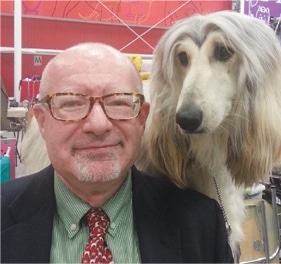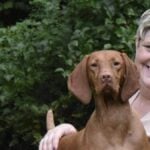
Home » Esthete English Setters | Dr. Jill Warren
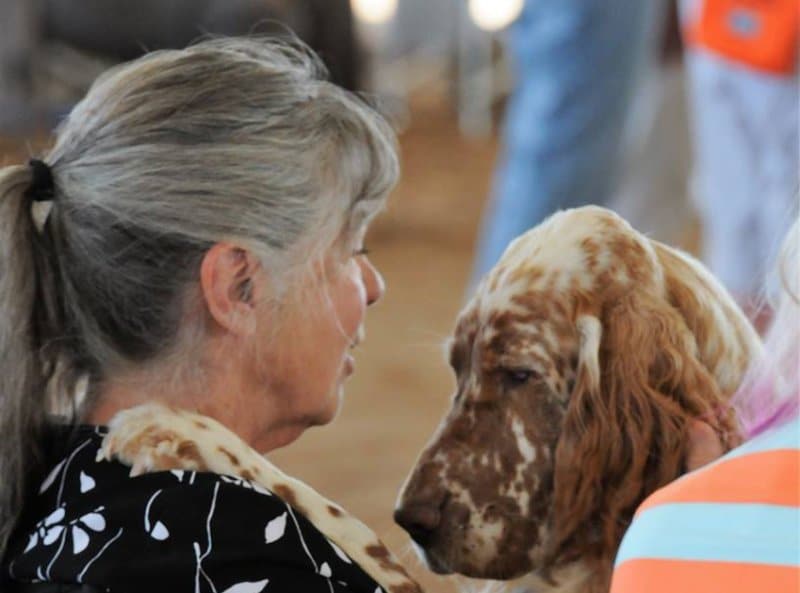
Dr. Jill Warren: I grew up near Toledo, Ohio.
Dr. Jill Warren: My family always had a dog but they were mixed breeds. When I got married, I assumed my husband and I would go to the pound and get a dog there, but he said, “Let’s get a purebred dog, one where someone has put some thought and care into its creation.”
He had had German Shorthaired Pointers and English Setters as a kid, so he wanted one of those, and I chose an English Setter.
We got our first two English Setters in the early 1980s. They were pets from show stock. In retrospect, I’m pretty sure both could have been shown to their championships. One died young of an autoimmune disease, so we were looking for another dog.
I contacted a breeder, and she asked, “Do you want a show dog?” I replied, “What’s a show dog?” We got a show-quality puppy, and in 1989, I started showing and never looked back.
I was in my early 40s at the time, so I got a late start. It is such an advantage to start as a junior or be born into a doggie family, so I had a steep learning curve to make up for lost time. However, my story tells you that it’s never too late to start.
Those were glory days for English Setters. Most specialties had 100 or more entries, most of the entries in the classes, and it took quite a large number to make a major.
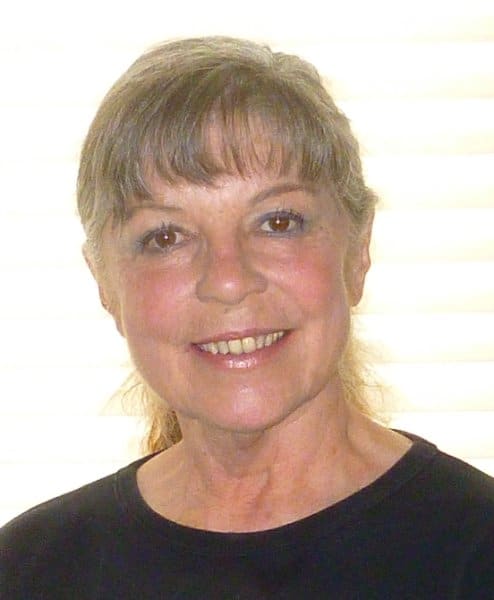
Dr. Jill Warren: In about 1988, I read an interview with Neal Weinstein of Guys ‘N’ Dolls English Setters in a great magazine called Setters Inc. From the interview, I could see this guy was a pivotal figure in English Setters. I got in touch and asked about buying a puppy. I met him and his wife Linda at the Seattle National in 1989 and was fortunate to be offered an adult bitch, Ch. Guys ‘N’ Dolls Jean Harlow, soon after. I jumped on that offer with all four feet. Neal helped me pick a stud dog for ‘Jeannie,’ and she produced Winners Dog at the National in her very first litter, shown by Eileen Hackett. Neal bred beautiful dogs, but one of his great achievements was his dogs’ awesome temperaments. Jeannie was the sweetest, happiest, and easiest-to-train dog one could ever want.
I got together with Neal every chance I could, and he shared his breeding philosophy and history freely. He told me that a key breeding for him was when he used Hillsdale Sentinel as a stud, as that gave him the style and pizzazz he wanted, and he nurtured that spark further with every breeding. He explained the ins and outs of inbreeding, linebreeding, and outcrossing to me. His favorite way to go was linebreeding. Once he had a selection of Guys ‘N’ Dolls dogs on the ground, he almost always bred Guys ‘N’ Dolls to Guys ‘N’ Dolls. He had two branches of his dog family that had different roots, and he liked to breed individuals from those branches together. He hardly ever outcrossed. He felt that he had to do a lot of clean up after an outcross.
Neal gave me some choices of dogs that I could breed Jeannie to, one of which was Ch. Guys ‘N’ Dolls Blame It On Rio, owned by Eileen Hackett. I picked ‘Rio,’ and that gave me the opportunity to work with Eileen, arguably now the Greatest Of All Time (GOAT) English Setter breeder. Eileen shared all her breeding knowledge freely and taught me how to show groom. We talked a lot about great dogs of the past and how they added to the development of English Setters. I met her at shows every chance I got, and drank in every drop of information she offered. She, too, bred Guys ‘N’ Dolls to Guys ‘N’ Dolls as long as she could until Neal passed and there were fewer and fewer dogs of his breeding available. Her current dogs are firmly rooted in Guys ‘N’ Dolls.
Eileen taught me what good structure is in English Setters and helped me develop my eye for evaluating dogs standing still and moving. She is a perfectionist that way.
I’ve had many other mentors over the years, and I am grateful to all of them for their help.
Dr. Jill Warren: First and foremost, I adhere to Form Follows Function. In order to be able to understand that, I had to see for myself English Setters working in the field to see how their structure (form) allows them to perform their original function of hunting upland game birds. That requires a balanced dog with proper angulation front and rear, and proper proportions of length of body to height, plus good muscle development, athleticism, and coordination. I place high value on balance and running gear on a dog. I recognize that head details and coloration are key components of breed type.
Hunting is hard in today’s society. You need access to birds and acreage, and a place where shooting guns is allowed. But it’s worth the effort to seek these things out and train one’s dogs in hunting. Also, seeing the pure joy they experience when they are given an opportunity to hunt—that’s the greatest gift an owner can give an English Setter or any Sporting breed. Most of my dogs have at least a JH, a few have an SH, and one achieved an MH.
I also like to train my dogs in Agility, Obedience, and Rally, so I am trying to breed the complete package with structure, breed type, AND brains, trainability, and drive—quite a challenge.
[wonderplugin_3dcarousel id=79]
Dr. Jill Warren: Four is a good number for me. I train each dog every day in Agility, Obedience, and Rally skills and take them to several classes a week. I also keep up their coats with frequent bathing and grooming. Finishing championships on all my dogs is important to me, so I also do regular Conformation training. If I have more than four, I can’t give them the daily one-on-one attention they thrive on.
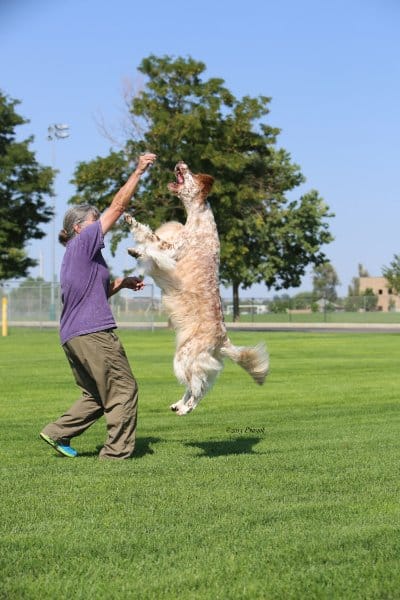
I have an acre fenced with my own covered 80 x 90 Agility field on the back of my lot. My dogs all live in the house, lie on the furniture, and sleep on the bed with me. I don’t have kennel runs. They run and play with each other outdoors every day. Agility keeps them physically fit, but nothing compares to the conditioning provided by hunting, where the dog does a full bore gallop for hours every day. When I want to train hunting, I find a field trainer to work with. There are none near me, so I rent a house at their location and train several times a week for six weeks or so at a time.
Dr. Jill Warren: The best dog I have bred is Ch. Esthete’s Splendor In The Grass RN (William), who showed from about 2000 to about 2005. He was No. 1 English Setter All-Breeds, won the Breed at the Garden, and won the National, campaigned by Valerie Atkinson. I wasn’t into the other dog sports then, but I now realize that the traits that made William a great show dog would have made him great in hunting, Agility, Obedience, and Rally. Those traits are the ability to handle pressure, never giving up under adverse conditions such as heat, never burning out, and always being up for anything. He did get a Rally Novice title with very little training. William had a fabulous front, proper proportions, and balance. At times, judges would call their colleagues into the ring and say things to the effect of “Check this dog’s superb front,” such a gratifying comment.
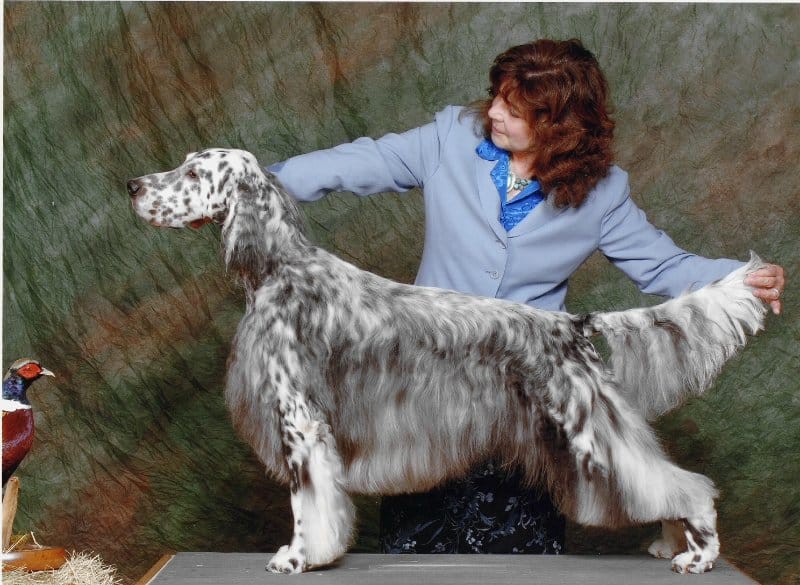
Another dog of whom I’m very proud is GCHG Esthete’s The Bard Of Avon CD BN RM MH NA NAJ NF CGC TKA (Shakespeare). Shakespeare had those same great show dog temperament traits that William had. William was his grandsire on both sides. We were chasing one of Eileen’s dogs in the standings and ended up No. 2 English Setter during Shakespeare’s campaign. I am always proud to stand in line behind Eileen. Shakespeare was campaigned by Lindsey Cook.
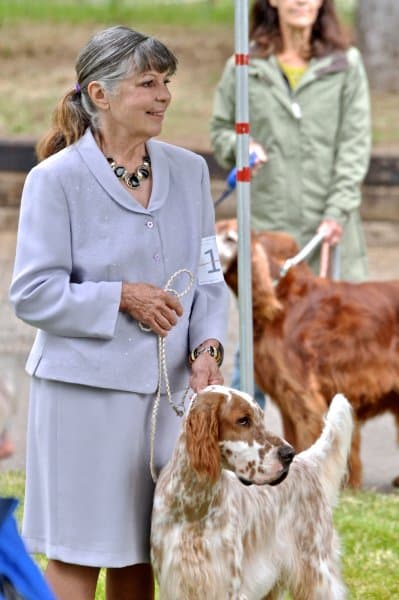
My favorite bitch that I’ve bred is Ch. PACH Esthete’s Satin Doll RN MX MXJ MXP4 MXPB MJP7 MJPS PAX NF XFP T2BP CGC TKN (Lorna). Lorna was a stand-out in Agility. She was a William granddaughter, and I bred her to William. She produced a litter of 11 outstanding puppies that excelled in many different venues. I thought 11 puppies was enough for a lifetime so I didn’t breed her again, but in retrospect, I wish I had.
Dr. Jill Warren: Although the number of English Setters being bred and shown has reduced drastically from when I started out, there are some outstanding individuals in the show ring these days.
A positive trend is the renewed interest in dual champions. I give a lot of credit to Frank Luksa for re-invigorating the quest for dual champions in our breed. Frank loves hunting so much that he named his daughter Hunter. M. A. Samuelson finished the first English Setter dual in 1980, and the 12th finished in 2002. For 15 long years, we languished at 12 dual champions. Those 12 took a lot of hard work by M.A., Terry Barnes, Mari Anderson, Sandi McCue, Kathy Rodriguez, Karen Kennedy, and Melissa Newman. Indeed, Melissa bred a National Specialty winner who went on to complete his dual, the ultimate achievement. Since Frank finished our 13th dual in 2017, there have been six more, trained by Steve and Shelley Garland, Ray McVeigh and Karen Lishinski, BJ Parsons, Frank Luksa, and Terry Barnes, with more on the way.
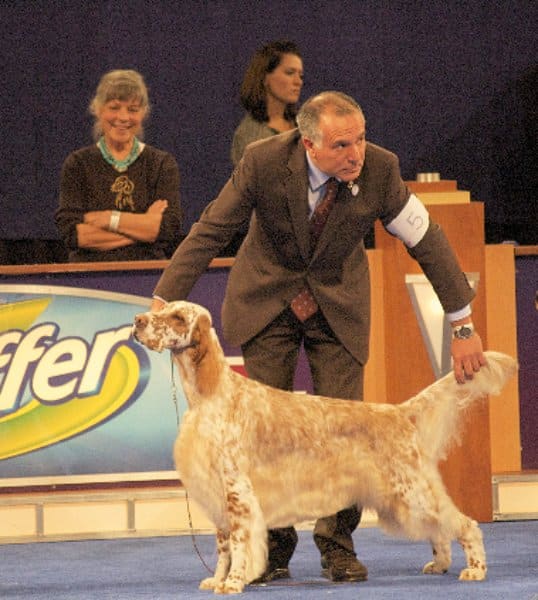
More and more people are discovering the versatility of the English Setter, and are training and showing them in many different venues, which makes my heart happy.
Another positive trend is the improvement in genetic health due to genetic screening. Through screening and selective breeding, we have reduced the incidence of hip and elbow dysplasia, deafness, and thyroid disease in the breed.
As far as trends that might bear watching—proportions (we are getting long and low), balance, and size. Our dogs are maintaining their size pretty well, but some of our bitches are getting tiny, to the point where a 24-inch bitch that fits the Breed Standard looks big in the ring compared to the others. Though we don’t have a height disqualification, there is a reason the Standard calls for bitches to be 24 inches and dogs to be 25 inches, and it has to do with being strong and sturdy enough to handle rigorous field conditions. If you want a dog that is smaller than that, get a Brittany, but don’t allow your English Setter to be sized down. I call on breeders and judges to understand that a 24-inch bitch is correct in size.
A trend that is alarming to me is the emphasis on extremely long coat, which is SO detrimental to a breed’s working ability. The function of coat is to protect the dog from cold weather and from twigs and branches in the field that could injure the dog. That’s it; that’s all. Coat longer than that hinders the dog from working in the field and is not necessary to breed type or anything at all except show ring wins. It turns off potential pet homes who would love an English Setter as the consummate family dog, but they don’t want the coat care. Ideally, you should be able to hunt your ES one day, bathe and brush it, and show it the next. The Standard calls for feathering of good length, but what we are seeing today is excessive length. Please, judges, help us out by not requiring that a dog be dripping in coat in order to receive the top awards.
More and more people are discovering the versatility of the English Setter, and are training and showing them in many different venues, which makes my heart happy.
Dr. Jill Warren: Treasure owner-handlers for what they are—the backbone of our sport. Stop thinking of the “regular” Group as the “real” Group and give as much prestige to the Owner-Handled Group as to the regular Group. When I started out, if owner-handlers worked hard to acquire the same skills and grooming proficiency as the pros, they could win at the top levels. Today, not so much. It’s become much more of a pro’s game. Be more welcoming to newcomers and reach out a helping hand. None of us is born knowing how to show and groom a dog, so help them learn.
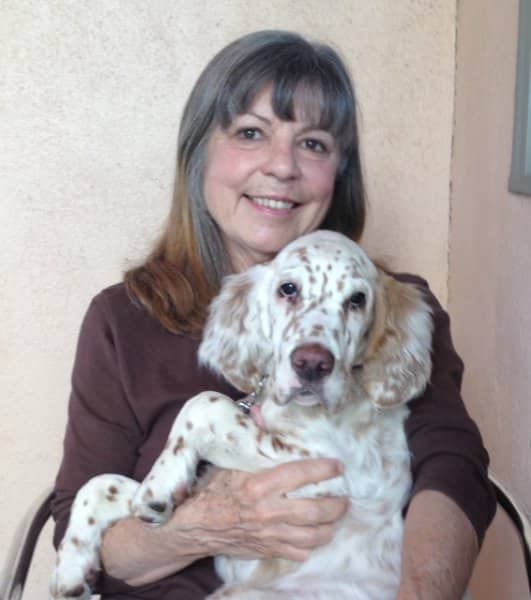
Dr. Jill Warren: I’m of an age where I won’t be breeding much more, if at all. I’m interested in breeders who produce the total dog—typey, athletic, smart, biddable, and with that fabulous English Setter temperament that is the breed’s trademark. If I were to breed a litter, that is what I would strive for.
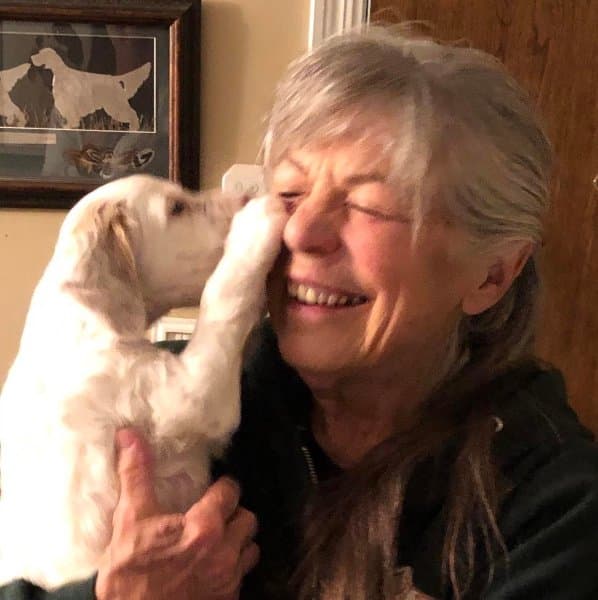
Dr. Jill Warren: My career started as a college professor of English. After I met my husband and moved to New Mexico, I became a technical writer at Los Alamos National Laboratory. That job was fabulous. I’ve been retired for several years.
I am a pro football fanatic. During football season, I am glued to the TV watching game after game unless I’m at a dog competition or judging at a dog show. Right now I’m excited about the play-offs, but after that, I’ll be in mourning when the season ends and there is that long wait until the next season.
I love rock music from the ‘60s through the ‘80s. If you ask me “Can music save your mortal soul?” (lyric from “American Pie”), I would shout a resounding “yes!” I go to rock concerts whenever I can.
I love all the arts—literature, art, and music—and attend exhibitions and performances whenever I can. My kennel name, Esthete, is the noun form of aesthetic and means a person who has a special appreciation of beauty, and that describes me to a “T.”
The best way to ensure a long and happy relationship with a purebred dog is to purchase one from a responsible breeder. Not sure where to begin finding a breeder?
Contact the National Parent Club’s Breeder Referral person, which you can find on the AKC Breeder Referral Contacts page.
Did you know nearly every recognized AKC purebred has a dedicated rescue group? Find your new best friend on the AKC Rescue Network Listing.
Showsight Magazine is the only publication to offer dedicated Digital Breed Magazines for ALL recognized AKC Breeds.
Read and learn more about the English Setter dog breed with articles and information in our English Setter Breed Magazine.
Error embedding FlippingBook shortcode, please check the flipbook url. (https://digital.showsightmagazine.com/view/966143/)
If you enjoy the English Setter Breed Magazine, help us educate the community by sharing it.
